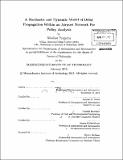A stochastic and dynamic model of delay propagation within an airport network for policy analysis
Author(s)
Pyrgiotis, Nikolaos
DownloadFull printable version (24.99Mb)
Other Contributors
Massachusetts Institute of Technology. Dept. of Aeronautics and Astronautics.
Advisor
Amedeo R. Odoni.
Terms of use
Metadata
Show full item recordAbstract
As demand for air travel increases over the years and many busy airports operate close to their capacity limits, congestion at some airports on any given day can quickly spread throughout the National Aviation System (NAS). It is therefore increasingly important to study the operation of large networks of airports as a group and to understand better the interactions among them under a wide range of conditions. This thesis develops a fundamental tool for this purpose, enhances it with several capabilities designed to address issues of particular interest, and presents some early insights and observations on the system-wide impacts of various scenarios of network-wide scope. We first describe an analytical queuing and network decomposition model for the study of delays and delay propagation in a large network of airports. The Airport Network Delays (AND) model aims to bridge the gap in the existing modeling tools between micro-simulations that track aircraft itineraries, but require extensive resources and computational effort, and macroscopic models that are simple to use, but typically lack aircraft itinerary tracking capabilities and credible queuing models of airport congestion. AND operates by iterating between its two main components: a queuing engine (QE), which is a stochastic and dynamic queuing model that treats each airport in the network as a M(t)/Ek(t)/1 queuing system and is used to compute delays at individual airports and a delay propagation algorithm (DPA) that updates flight schedules and demand rates at all the airports in the model in response to the local delays computed by the QE. We apply AND to two networks, one consisting of the 34 busiest airports in the United States and the other of the 19 busiest in Europe. As part of the development of AND, we perform a statistical analysis of the minimum ground turn-around times of aircraft, one of the fundamental variables that determine delay propagation. In addition, we show that the QE, with proper calibration, can model very accurately the airport departure process, predicting delays at two major US airports within 10% of observed values. We also validate the AND model on a network-wide scale against field data reported by the FAA. Finally, we present insights into the complex interactions through which delays propagate through a network of airports and the often-counterintuitive consequences. In the third part of the thesis, we present two important extensions of the AND model designed to expand its usability and applicability. First, in order to provide a more accurate representation of NAS operations, we develop an algorithm that replicates quite accurately the execution of Ground Delay Programs (GDPs). The algorithm operates consistently with the rules of the Collaborative Decision-Making (CDM) process under which GDPs are currently conducted in the United States. The second extension is the implementation in AND of a deterministic queuing engine (D(t)/D(t)/1) which can be used as an alternative to the original stochastic QE. This deterministic model can be used to study delay-related performance in a future system that operates at a higher level of predictability than the current one, as the one envisioned by FAA in the Next Generation Air Transportation System. In the final part of the thesis we describe a Mixed Integer optimization model for studying the impact of introducing slot controls at busy airports. The model generates new flight schedules at airports by reducing the number of available slots, while respecting all existing aircraft itineraries and preserving all passenger connections. We test the model at Newark Airport (EWR) and conclude that, with a small schedule displacement (less than 30 minutes for any flight during the day), it is possible to obtain a feasible schedule that obeys slot limits that are as low as the IFR capacity of the airport. We test the new schedule in AND and find that the local delay savings that would result from "slot-controlling" EWR in this way are of the order of 10% for arrivals and of 50% for departures, while we may also expect a reduction of 23% in propagated delays to the rest of the US network of airports.
Description
Thesis (Ph. D.)--Massachusetts Institute of Technology, Dept. of Aeronautics and Astronautics, 2012. Cataloged from PDF version of thesis. Includes bibliographical references (p. 223-227).
Date issued
2012Department
Massachusetts Institute of Technology. Department of Aeronautics and AstronauticsPublisher
Massachusetts Institute of Technology
Keywords
Aeronautics and Astronautics.